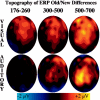Differentiating amodal familiarity from modality-specific memory processes: an ERP study
- PMID: 14986851
- PMCID: PMC1413574
- DOI: 10.1111/1469-8986.00116
Differentiating amodal familiarity from modality-specific memory processes: an ERP study
Abstract
Distinct event-related potential effects have been related to familiarity and recollection processes underlying recognition memory. Familiarity has been conceptualized as similar either to perceptual priming mechanisms supporting implicit memory or to amodal global-matching processes that should show little sensitivity to perceptual variables. The present experiment manipulated the study modality of words (auditory, visual) that were visually tested for recognition memory. The mid-frontal (300-500 ms) old/new effect often attributed to familiarity was not affected by study modality, so it appears related to an amodal familiarity process. An earlier (176-260 ms) fronto-polar old/new effect was perceptually specific in that it was observed only following visual study. The parietal old/new effect (400-800 ms), often attributed to recollection, was similar following both visual and auditory study. Temporal-spatial PCA clarified the separability of these effects.
Figures






Similar articles
-
Event-related potentials and recognition memory.Trends Cogn Sci. 2007 Jun;11(6):251-7. doi: 10.1016/j.tics.2007.04.004. Epub 2007 May 3. Trends Cogn Sci. 2007. PMID: 17481940 Review.
-
Has the butcher on the bus dyed his hair? When color changes modulate ERP correlates of familiarity and recollection.Neuroimage. 2006 Oct 1;32(4):1879-90. doi: 10.1016/j.neuroimage.2006.04.215. Epub 2006 Jun 14. Neuroimage. 2006. PMID: 16777433 Clinical Trial.
-
Event related brain potentials and illusory memories: the effects of differential encoding.Brain Res Cogn Brain Res. 2001 Jan;10(3):283-301. doi: 10.1016/s0926-6410(00)00049-5. Brain Res Cogn Brain Res. 2001. PMID: 11167052
-
Brain potentials of recollection and familiarity.Mem Cognit. 2000 Sep;28(6):923-38. doi: 10.3758/bf03209340. Mem Cognit. 2000. PMID: 11105518
-
Multiple ways to the prior occurrence of an event: an electrophysiological dissociation of experimental and conceptually driven familiarity in recognition memory.Brain Res. 2010 Nov 11;1360:106-18. doi: 10.1016/j.brainres.2010.08.089. Brain Res. 2010. PMID: 20816760
Cited by
-
Electrophysiological correlates of exemplar-specific processes in implicit and explicit memory.Cogn Affect Behav Neurosci. 2012 Mar;12(1):52-64. doi: 10.3758/s13415-011-0065-7. Cogn Affect Behav Neurosci. 2012. PMID: 22038704
-
Large EEG amplitude effects are highly similar across Necker cube, smiley, and abstract stimuli.PLoS One. 2020 May 20;15(5):e0232928. doi: 10.1371/journal.pone.0232928. eCollection 2020. PLoS One. 2020. PMID: 32433672 Free PMC article.
-
Time course of EEG oscillations during repeated listening of a well-known aria.Front Hum Neurosci. 2015 Jul 20;9:401. doi: 10.3389/fnhum.2015.00401. eCollection 2015. Front Hum Neurosci. 2015. PMID: 26257624 Free PMC article.
-
Top-down resolution of visual ambiguity - knowledge from the future or footprints from the past?PLoS One. 2021 Oct 21;16(10):e0258667. doi: 10.1371/journal.pone.0258667. eCollection 2021. PLoS One. 2021. PMID: 34673791 Free PMC article.
-
Color and context: an ERP study on intrinsic and extrinsic feature binding in episodic memory.Mem Cognit. 2007 Sep;35(6):1483-501. doi: 10.3758/bf03193618. Mem Cognit. 2007. PMID: 18035643
References
-
- Allan K, Wilding EL, Rugg MD. Electrophysiological evidence for dissociable processes contributing to recollection. Acta Psychologica. 1998;98:231–252. - PubMed
-
- Bertrand O, Perin F, Pernier J. A theoretical justification of the average reference in topographic evoked potential studies. Electroencephalography and Clinical Neuroscience. 1985;62:462–464. - PubMed
-
- Craik FIM, Moscovitch M, McDowd JM. Contribution of surface and conceptual information to performance on implicit and explicit memory tasks. Journal of Experimental Psychology: Learning, Memory, and Cognition. 1994;20:864–875. - PubMed
-
- Curran T. The electrophysiology of incidental and intentional retrieval: ERP old/new effects in lexical decision and recognition memory. Neuropsychologia. 1999;37:771–785. - PubMed
-
- Curran T. Brain potentials of recollection and familiarity. Memory & Cognition. 2000;28:923–938. - PubMed
Publication types
MeSH terms
Grants and funding
LinkOut - more resources
Full Text Sources
Medical

